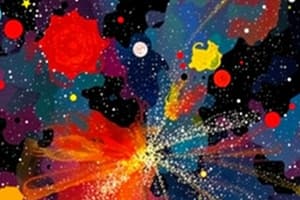Podcast
Questions and Answers
What are the properties of stars that help us classify them?
What are the properties of stars that help us classify them?
- Color
- Temperature
- Size
- All of the above (correct)
How do a star's color and temperature relate?
How do a star's color and temperature relate?
The surface temperature of a star determines the color of light it emits.
How do stars form?
How do stars form?
From an accumulation of gas and dust that collapses due to gravity.
What determines how long a star's life cycle is?
What determines how long a star's life cycle is?
What happens when a star runs out of fuel?
What happens when a star runs out of fuel?
What objects form during the death of a star?
What objects form during the death of a star?
How do stars produce elements?
How do stars produce elements?
Label the stages of a star's life cycle: Massive stars transform into _____ while average stars end life as a _____
Label the stages of a star's life cycle: Massive stars transform into _____ while average stars end life as a _____
Flashcards are hidden until you start studying
Study Notes
Classification of Stars
- Stars are classified based on color, temperature, size, composition, and brightness.
- Chemical composition varies significantly among stars.
Color and Temperature Relationship
- A star's surface temperature determines its emitted light color.
- Blue stars are the hottest, followed by yellow, then red stars.
- Small B - V values indicate bluer (hotter) stars, while larger values indicate redder (cooler) stars.
Formation of Stars
- Stars form from the accumulation of gas and dust that collapses under gravity.
- The star formation process can take about a million years, starting with a collapsing gas cloud until a star shines.
Star Life Cycle and Color Determination
- A star's future is influenced by its initial mass, with massive stars contrasting significantly from low/medium mass stars post-red giant phase.
- Star color correlates with surface temperature; hotter stars emit shorter wavelengths (blue/blue-white), while cooler stars emit longer wavelengths (red/red-brown).
Fate of Stars Upon Fuel Depletion
- Main sequence stars transition to red giants or red super giants as they exhaust hydrogen fuel.
- Low/medium mass stars shed their outer layers to form a planetary nebula after becoming red giants.
Objects Formed at Star's Death
- Stars like the Sun expand into red giants, potentially engulfing nearby planets like Mercury and Venus.
- Post outer layer expulsion, the core collapses into a dense white dwarf.
Element Production in Stars
- Stars produce new elements through nuclear fusion in their cores.
- Initial fusion involves hydrogen atoms fusing into helium, with subsequent fusions creating heavier elements, up to iron.
Stages of a Star's Life Cycle
- Massive stars end their lives as supernovae, neutron stars, or black holes.
- Average stars like the Sun conclude their life cycle as white dwarfs surrounded by a planetary nebula.
- All stars undergo a common 7-stage life cycle, beginning as gas clouds and ending as remnants.
Studying That Suits You
Use AI to generate personalized quizzes and flashcards to suit your learning preferences.




